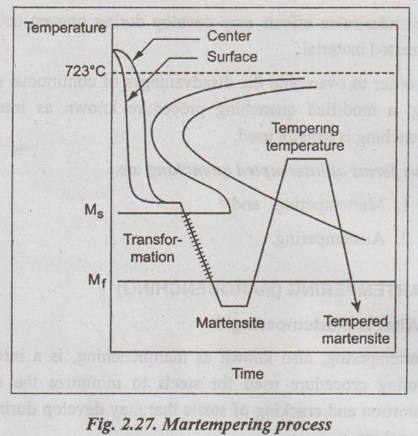Martempering, also known as marquenching, is a interrupted cooling procedure used for steels to minimize the stresses, distortion and cracking of steels that may develop during rapid quenching.
MARTEMPERING (MARQUENCHING)
1. What is Martempering ?
✓ Martempering, also known as marquenching, is a interrupted cooling procedure used for steels to minimize the stresses, distortion and cracking of steels that may develop during rapid quenching.
2. Martempering Process
The martempering process consists of the following steps:
Step 1: Austenitizing the steel, i.e., heating the steel above its critical range to make it all austenite.
Step 2: Quenching the austenitized steel in hot oil or molten salt at a temperature just slightly above the martensite start temperature (Ms).
Step 3: Holding the steel in the quenching medium until the temperature is uniform throughout and stopping this isothermal treatment before the austenite-to-bainaite transformation begins.
Step 4: Cooling at a moderate to room temperature (usually in air) to prevent large temperature differences between center and surface. Fig.2.27 shows a cooling path for the martempering process.
✓ The resulting microstructure of the martempered steel is untempered martensite.

✓ Now the untempered martensite structure is transformed into tempered martensite structure by the conventional tempering heat treatment processing rapid quenching.
Note
Here it may be noted that despite the name of martempering, no tempering occurs. That's why this process is more appropriately called marquenching.
3. Application
The martempering process is mostly used in alloy steels.
4. Advantages of Martempering
The main advantages of martempering are:
1. Minimised quenching stresses.
2. Minimised chances of formation of quenching cracks.
3. Less distortion or warping.
No comments:
Post a Comment